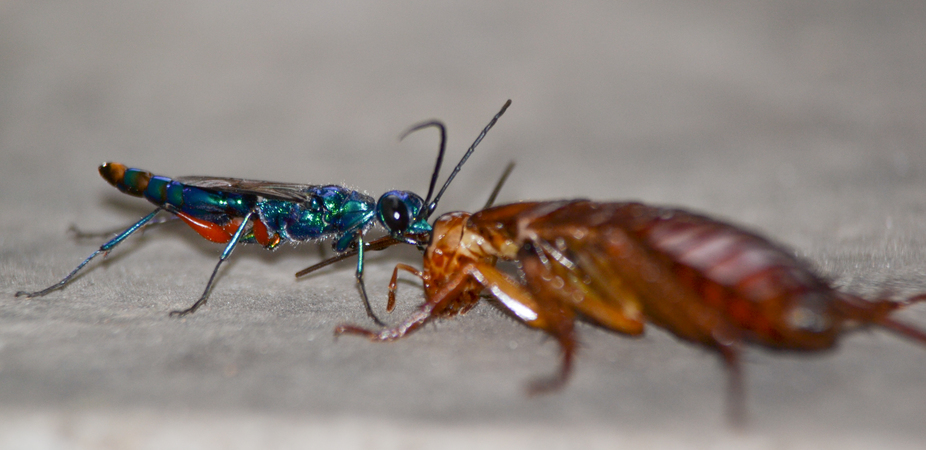
This article was originally published at The Conversation. The publication contributed the article to Live Science's Expert Voices: Op-Ed & Insights.
For decades, scientists have tried to understand the complex and gruesome relationship between the parasitic emerald wasp Ampulex compressa and its much larger victim, the common household cockroach Periplaneta americana.
At first glance, this parasite-prey relationship seems much like any other: the female wasp stings the cockroach, lays an egg on its abdomen, and once hatched, the hungry larva feeds on the cockroach. However, while most parasitic insects tend to paralyse their victims with a venomous sting, the emerald wasp instead manipulates the cockroach’s behaviour, essentially transforming it into a zombie slave.
With two stings the cockroach is left with the ability to walk, but is entirely robbed of the power to initiate its own movement. The wasp, now tired after administering two stings, regains its energy by cutting off the ends of the cockroach’s antennae, and drinking its blood. Revitalised, it then latches on to the stung cockroach’s antennae and, much like an obedient toddler being lead to his first day of school, the submissive insect follows the wasp’s orders.
In the meantime the wasp also lays an egg on the cockroach, which hatches after three or four days. The hatched larva chews its way into the cockroach’s abdomen, where it proceeds to eat the internal organs in a precise order. This ensures that the docile victim stays alive for the next four days, until the larva eventually forms a cocoon inside it.
With time, the fully-grown wasp emerges from the host’s body and continues this vicious cycle. Through it all, the stupefied roach, although able to move, shows no desire to struggle, flee, or fight, even as it is being eaten alive from the inside.
How to control a roach
This wasp-cockroach relationship has been documented as early as the 1940s, but it wasn’t until recently that scientists have been able to understand how exactly the wasp pulls off this precise behavioural manipulation.
Get the world’s most fascinating discoveries delivered straight to your inbox.
The first sting, administered to a mass of nerve tissue in the cockroach’s thorax, contains large quantities of gamma amino butyric acid (GABA), and complementary chemicals called taurine and beta alanine. GABA is a neurotransmitter that blocks the transmission of motor signals between nerves, and, together with the other two chemicals, it temporarily paralyses the cockroach’s front legs. This prevents the cockroach from escaping while the wasp inflicts the second, more toxic sting directly into the roach’s brain.
It is the second sting that turns the cockroach into a zombie, and contains what Frederic Libersat and his colleagues at Ben Gurion University refer to as a “neurotoxic cocktail”. The venom of the second sting blocks the receptors for another neurotransmitter called octopamine, which is involved in the initiation of spontaneous and complex movements such as walking.
Libersat has shown that unstung cockroaches injected with an octopamine-like compound show an increase in walking behaviour. Those injected with a chemical that blocks octopamine, however, show a reduction in spontaneous walking, much like the victims of the wasp sting. Zombie cockroaches were also able to recover from their stupor and walk after they were injected with a chemical that reactivates octopamine receptors.
There is a fine distinction between the ability to walk, and the ability to initiate such a movement. The stung cockroaches in this instance are devoid of the latter, while their skills for the former seem intact, demonstrated by the fact that these poor creatures are entirely capable of walking to the wasp’s nest, but only when being led by the wasp.
Libersat and colleagues investigated this interesting phenomenon by placing stung cockroaches in potentially harmful situations and testing their escape reflexes. They found that cockroaches stung by the emerald wasps were soon deprived of any will to escape to safety even when electrocuted or drowned. However, their motor skills, measured by the contractions of their muscles when subjected to these dangers, were the same as unstung cockroaches, suggesting that the venom affects the decision rather than the ability to walk.
However haunting this behavioural manipulation is, one can’t help but appreciate the ingenuity of this tiny parasite, enabling it to incapacitate a much bigger victim. If the wasp were to paralyse the cockroach, it probably would not be able to carry it back to its lair. If it were to kill the cockroach, it would lose its source of fresh food. It has evolved to develop the most complex and precise weapon to overcome these two obstacles: venom that only targets the specific neural circuits which guarantee that its victim will walk obediently to its tomb, and stay alive while it is being devoured. And with no will to escape, these poor roaches help another generation of terrifying emerald wasps to be spawned.
Next, read this: The crab-castrating parasite that zombifies its prey
Sana Suri blogs at http://neurobabble.co.uk.
This article was originally published on The Conversation. Read the original article. Follow all of the Expert Voices issues and debates — and become part of the discussion — on Facebook, Twitter and Google +. The views expressed are those of the author and do not necessarily reflect the views of the publisher. This version of the article was originally published on Live Science.

